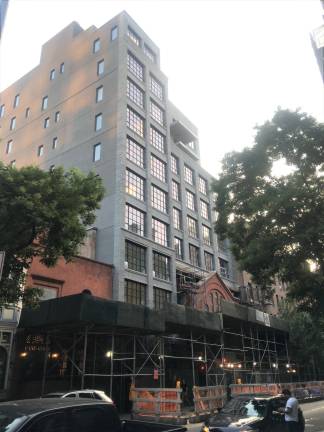Chelsea’s forgotten french past

Unlike many of the ethnic communities that have flavored New York’s melting pot, the French are not usually linked with a particular neighborhood. A century ago, however, Chelsea was the ‘French Quarter’ of New York City.
In the city’s early days, New York’s French community clustered south of Washington Square, but as Manhattan spread northwards in the late 1800s, the center of French life shifted to the blocks north of 14th Street and West of Broadway.
In 1894, the Sun reported that “Twenty-sixth street west of Sixth Avenue begins to take on the air of the old French quarter. It has several French restaurants, three or four French shoemakers, displaying odd, shapeless specimens of their own handiwork; a French grocer or two, and several French bushelling tailors.”
The New York Times wrote in 1902 about “New York’s French colony” of 26,000 residents in a city of four million. “These people constitute a rather remarkable body of importers, professional men, teachers, artists, musicians, chefs, waiters, artisans, forming a desirable element of the community.”
By World War II, the French of Chelsea had mostly moved on, but a few traces of their presence can still be found around the neighborhood.
St Vincent de Paul Catholic Church123 West 23rd Street The parish of St. Vincent de Paul formed in 1841 to serve the spiritual needs of New York’s French Catholics. The 1869 dedication of a new church on West 23rd Street helped establish Chelsea as the new heart of the French community. According to the New York Times in 1902, the orphanage of St. Vincent de Paul was established “by furnishing shelter for two waifs” in the rectory behind the church on West 24th Street.
For 170 years, the parish served French speakers from all walks of life. In 1952, Edith Piaf married her first husband at St Vincent de Paul, with matron of honor Marlene Dietrich at her side. In more recent years, worshippers were more likely to hail from West Africa or Haiti than France.
Despite appeals by parishioners to keep the parish open, the church held its last French mass in 2013. Efforts to obtain landmark designation failed as well, leaving the property open for redevelopment.
The new owner has filed plans to build two towers connected at the base by the existing church. If the plan proceeds, St Vincent de Paul’s main facade and perhaps its barrel-vaulted interior may live on, but within a drastically different context. The boarded-up sanctuary lost its circular rose window in the 2016 Chelsea bombing, but otherwise quietly waits to learn its future. The old rectory on 24th Street was demolished late last year.
French Evangelical Church126 West 16th Street The fate of another French-speaking congregation’s old church may shed light on what the future holds for St Vincent de Paul. The French Evangelical Church has ministered to its flock since 1866 in its red brick sanctuary on West 16th Street.
To raise money for much-needed repairs on the 180-year-old building, the congregation sold its air rights in 2014 to a condo developer, who is nearing completion on an 11-story glass, steel and concrete structure that cantilevers above the old church. Neighbors protested but were unable to stop the project.
Home for French Working Girls341 West 30th Street In the late 1800s, the French Evangelical Church opened a home for young women in need of temporary lodging. The home was located on West 30th Street in 1912, when the New York Observer reported that “shelter is afforded these young French women, while seeking and obtaining employment as teachers, governesses, maids or nurses. The number of those who, during its existence, have availed themselves of the benefits of this institution is upwards of nine thousand.” The four-story brick townhouse has more recently operated as a hostel and is now an apartment building.
French Hospital330 West 30th Street/329 West 29th StreetIn 1881, the French Benevolent Society, a local charitable organization, opened a hospital on West 14th Street to assist the local French community. Staffed by the Sisters of the Holy Cross, the hospital admitted patients of all backgrounds and quickly outgrew three early locations, prompting the society to build a new 12-story hospital on West 30th Street in 1928. Its most famous patient was Babe Ruth, who was treated for cancer at the hospital in the late 1940s. Many babies entered the world in the hospital’s 62-bed maternity ward on West 29th Street.
The hospital closed for good in 1977 and is now the “French Apartments,” but etched into the building itself are a few reminders of its former life: the words ‘Société Française de Bienfaisance” are carved above the main entrance and “Clinic Entrance” marks a side door.
Located a few doors away at 317 West 29th, is a remodeled building that once housed the Petitpas boardinghouse and restaurant run by three French sisters. Popular in the early 20th century with artists and poets, the courtyard patio was immortalized in John Sloan’s circa 1910 painting, “Yeats at Petitpas.”
Jeanne D’Arc Residence253 West 24th Street Another home established as short-term housing for young French women, the Jeanne D’Arc Residence has provided affordable rooms to working women and students since 1898. Operated by the Sisters of Divine Providence, the home’s facilities include a small chapel.